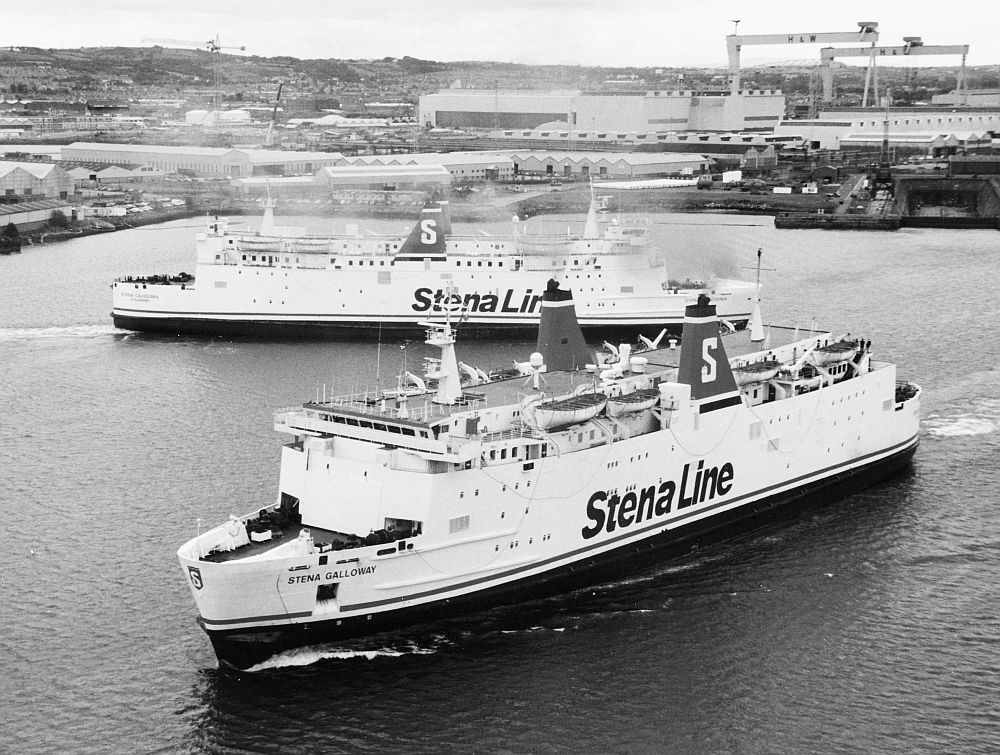This page is part one of four. The other parts are:
—
Former ferries of NI Pt.2: From Atlantic Steam Navigation to P&O
—
Former ferries of NI Pt.3: Seatruck, Merchant Ferries, Norse Irish, DFDS, and other NI to England operators
—
Former ferries of NI Pt.4: Isle of Man Steam Packet and SeaCat
Please click on the thumbnail to view the full image along with caption and copyright information.
This page is best viewed on a computer or tablet.

In 1969 responsibility for the shipping services run by nationalised British Rail was taken away from the individual BR regions and given to the a new division called the British Rail Shipping and International Services Division. From 1970 to 1984 these services were marketed under the Sealink name. During this period the passenger only vessels traditionally used by the railway companies were gradually replaced by roll-on-roll-off vehicle and passenger ferries. However, services to Northern Ireland from Scotland had roll-on-roll-off vessels since 1948, with Larne and Stranraer being the first ports in the UK with drive on ramps.
In readiness for privatisation the ferry business was incorporated as Sealink UK Limited in 1978. This followed a decline in the traditional rail-linked passenger traffic on the ferries and the increase in both passenger and freight vehicular traffic on Sealink services. The UK Government sold Sealink UK to Sea Containers on 27 July 1984. Sea Containers rebranded the operation as Sealink British Ferries, adapting the recently adopted new Sealink livery adopted for privatisation in the process.
[foogallery id=”8933″]
.

Sealink was the shipping division of then nationalised British Rail. As part of the preparations for privatisation a new livery designed by H&P associates to differentiate the operation from the British Rail corporate image was introduced on the newly acquired (on charter from Stena) ST. NICHOLAS in March 1984. On 27 July 1984 the British government sold the core passenger and vehicle ferry business of Sealink to Sea Containers for £66m. The company was renamed Sealink British Ferries and used a modified version of the new livery.
[foogallery id=”8934″]
.


In the spring of 1990 the majority of the Sealink British Ferries business was sold to Stena Line following a hostile takeover bid (the sale excluded the English Channel hovercraft and Isle of Wight services though, which Sea Containers retained). Stena would rebrand the services as first Sealink Stena Line, then Stena Sealink Line, before finally rebranding the operation as Stena Line in 1996.
[foogallery id=”8935″]
.

In 1996 the Sealink brand disappeared from the UK ferry scene altogether following the decision by Stena Line to operate their UK services under the Stena Line brand without reference to Sealink. In Northern Ireland the change of branding coincided with the switch of port from Larne to a new purpose-built terminal at Belfast’s Albert Quay on the site of the former P&O Ardrossan terminal. Later that year Stena introduced their revolutionary HSS fast ferry HSS STENA VOYAGER to the route in direct completion with SeaCat who operated from Belfast’s Donegall Quay to Stranraer using a much smaller InCat craft. Stena Line UK and Ireland is based at Stena House in Holyhead, having moved from the former Sealink officies in Ashford (Kent). Stena Line no longer operate from the Albert Quay terminal, with services to Heysham (freight only), Birkenhead and Cairnryan operating from Victoria Terminal 1, 2, and 4 instead.
[foogallery id=”8936″]
.
The above article is Copyright © Steven Tarbox, all rights reserved. All photographs are Copyright of their named Copyright holders. Unauthorised reproduction or distribution in whole or in part is strictly prohibited. Sealink British Ferries, Sealink Stena Line, and Stena Sealink Line logos digitally reproduced by Steven Tarbox. The name Sealink remains a trademark of Stena and is used here for informational purposes.
With thanks to the all of the named contributors for the use of their images.
Original articles published: June 2015
Rebuilt, articles merged, updated, and moved to new location: 12 October 2017 – Feb 2018
last updated: 30.06.19
